Discover Lord Murgan Temples in Tamilnadu (Nov 21st – 29th)
The year 2023 was the year of consolidating funds and selling and buying houses. I sold my mother’s magnificent flat on the water front in Wellington New Zealand and bought another in Mottingham south-east London to rent. The taxes and expenses were making it uneconomical to keep the NZ flat and I wanted to free some capital for future travels to India.
Semi retirement at the age of 66 meant I was not earning a lot in London even though I still work four days a week and India travels had to be financed. There was also a plan to invite Anju to London and to give Om the money to build a shelter in Rada Kund.
Also wanted to see the folks back home in New Zealand: My friend since 1979 Yvonne and the land which the government was doing its best to take from her, Paul my ex husband who needed a shoulder replacement, Nina my lovely cousin who looked after my mother during her last days on this planet, my step sister Tony who lives down south in Dunedin and needs comforting after the loss of her partner, other family members, Peter an ex boyfriend with whom I still exchange emails every week and various friends. Had to leave NZ in a hurry last time in 2020 due to covid and never completed the holiday. It felt like unfinished business had to be finished.
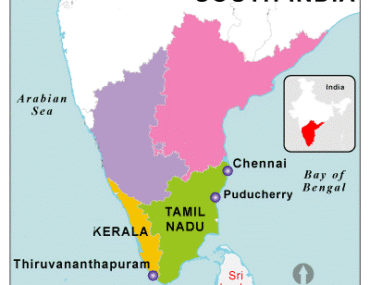
Om Prakash said sell you NZ flat and come to India. India was going to happen again in 2024 in April but it seemed a long way away. Decided to stop off in the south for a week and found a trip with Incredible India. And there was Om’s smiling face on the website. He arranged everything for the South India temple tour and is coming with me and his son Siddharth. After the tour Anju will meet us in New Delhi.
I am paying for their stay in New Delhi and for the flights. It will be great to see them. And also Kushboo the fiancée of Vipal one of my flat mates who says she loves the way I love India. Charming lady, intelligent, pretty, hard work and good fun. Om and family I will see on the way to India and Kushboo on the way back. Want to break the journey from NZ back to the UK and Delhi will be great in the cooler weather of January.
Om felt the trip to the south was an excellent idea. Many of the temples in London are south Indian temples run by Tamils so I have an idea of what I am letting myself in for. And no guide. Om would be the guide.
Organisation was easy. Just a matter of booking the flights and sending the money to Om which my boss at the Ayurvedic clinic agreed to do. Coming from an Indian bank account there would be no bank charges. Flights were booked at Trail finders with a Polish lady. Len came with me. He enjoyed the discussions about the stop overs and was a great help reminiscing about his time in the travel business.
Overview: Murgan Temples in Tamilnadu
Was surprised to learn about the culture of South India which has evolved against the backdrop of 5000 years of rich history, during which peninsular India has changed hands several times. The period of known history of southern India begins with the Iron Age (c 1200 BCE to 200 BCE), Sangam period (c. 600 BCE to 300 CE) and medieval south India until the 15th century CE.
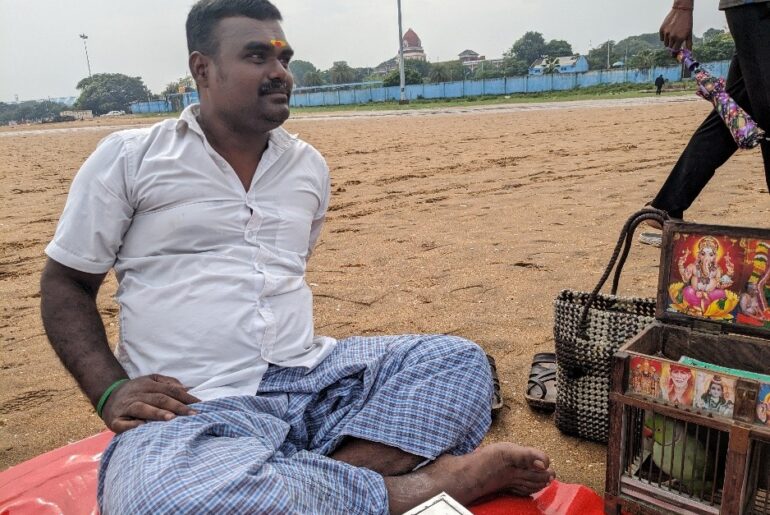
The three ruling houses of Tamil India, the Pandyas, Cheras, and Cholas, fought for supremacy of southern India and Sri Lanka. These dynasties promoted early literature on the Indian subcontinent and built important Hindu temples.
Tamil Nadu is India’s 10th largest state the homeland of one of humanity’s living classical civilisations. It’s culture, stretching back uninterrupted for two millennia, is very much alive today in the Tamils’ language, dance, poetry and forms of Hinduism.
This state is located in the extreme south of the subcontinent bounded by the Indian Ocean to the east and south and by the states of Kerala to the west, Karnataka (formerly Mysore) to the northwest, and Andhra Pradesh,to the north. Enclosed by Tamil Nadu along the north-central coast are the enclaves of Pondicherry and Karaikal, both of which are part of the Pondicherry Union Territory. The capital is Chennai (formerly Madras) on the coast in the northeastern portion of the state.
Tamil Nadu represents the Tamil speaking area of what was formerly the Madras Presidency of British India. The Tamils are especially proud of their Dravidian language and culture and have notably resisted attempts by the central government to make Hindi an Indo-Ayran language the sole national language. The people speak Tamil and English and few know Hindi. While it has an industrial core in Chennai, the state is essentially agricultural with an area of 50,216 square miles and a population of 72,138,958.
Tuesday 21st November, 2023 ( Murgan Temples in Tamilnadu )
The bags were packed and it was just a matter of cleaning my room and getting to the airport. Almost dropped my bag on the down escalator getting to the Elizabeth Line. A very helpful Caribbean lady helped me and the ride was quick and pleasant.
On the automated bag drop was asked to wait and an officious Indian lady asked if I had a visa. Then the bag was gone and waited for Len in the café Nero. We exchanged a few quick words and off I went through security.
The gate necessitated a ride on a shuttle bus to another terminal. A young Indian man appeared and took me to where I needed to go. It was as if Krishna had sent someone to ease my path on the journey. The same thing happened on my last trip.
On the flight sat next to a pleasant French man who was travelling to Pondicherry where the French were a big number once. His English got better during the flight especially after three small bottles of red wine.
The lady next to me spoke a lot about being a Brahmin and a vegetarian and then demolished an English breakfast with great relish. She was fascinated that I was going to visit the temples of Lord Murgan and gave me a big hug before she disembarked.
Wednesday 22nd November 2023
Slept for most of the flight and felt peaceful when I stepped into the warmth of Chennai. Not quite like stepping into an oven but definitely very warm.
The young man on immigration asked me if I had come from New Zealand and I told him I had come from the UK on a New Zealand passport as India was not giving e visas to British nationals at the time I applied for the visa.
Honesty is the best policy. He smiled and said “It’s okay”. The representative from Memorable India was there with a sign with my name and off we drove to the Hotel Residency.
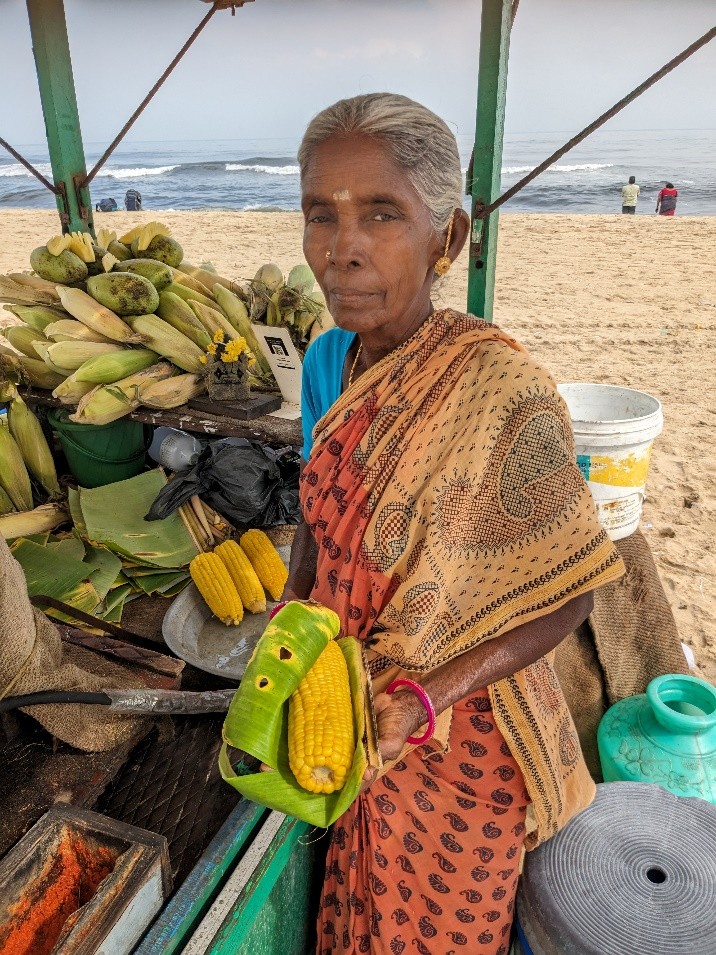
Chennai : Pic Indian Express
Madras was the shortened name of the fishing village Madraspatnam, where the British East India Company built a fort and factory (trading post) in 1639–40. Tamil Nadu officially changed the name of the city to Chennai in 1996. Chennai, on the Bay of Bengal in eastern India, is the capital of the state of Tamil Nadu.
The city is home to Fort St. George, built in 1644 and now a museum showcasing the city’s roots as a British military garrison and East India Company trading outpost, when it was called Madras. From the 17th century, Madras became a city of key importance within the British network of maritime trade routes, exporting locally produced cotton and chintz, as well as many different spices and other cargoes imported from the east.
Since the late 1990s, software development and electronics manufacturing have made up the bulk of Chennai’s economy. Numerous technology parks, where many foreign companies have offices, are found throughout the city.
Other major industries include the manufacture of automobiles, rubber, fertilizer, leather, iron ore, and cotton textiles. Wheat, machinery, iron and steel, and raw cotton are imported. There is an oil refinery in Chennai. Services, especially finance and tourism, are also significant.
The Indian Bank and Indian Overseas Bank, both administered by the Ministry of Finance, are headquartered in Chennai. Hotels, luxury resorts, restaurants, marinas, and parks line Marina Beach, the coastline abutting Chennai city.
The municipal government called Chennai Corporation, was established in 1688 and is the oldest surviving municipal governing body in India. Chennai Corporation is governed by a council, elected to five-year terms. The mayor is elected from among the councillors.
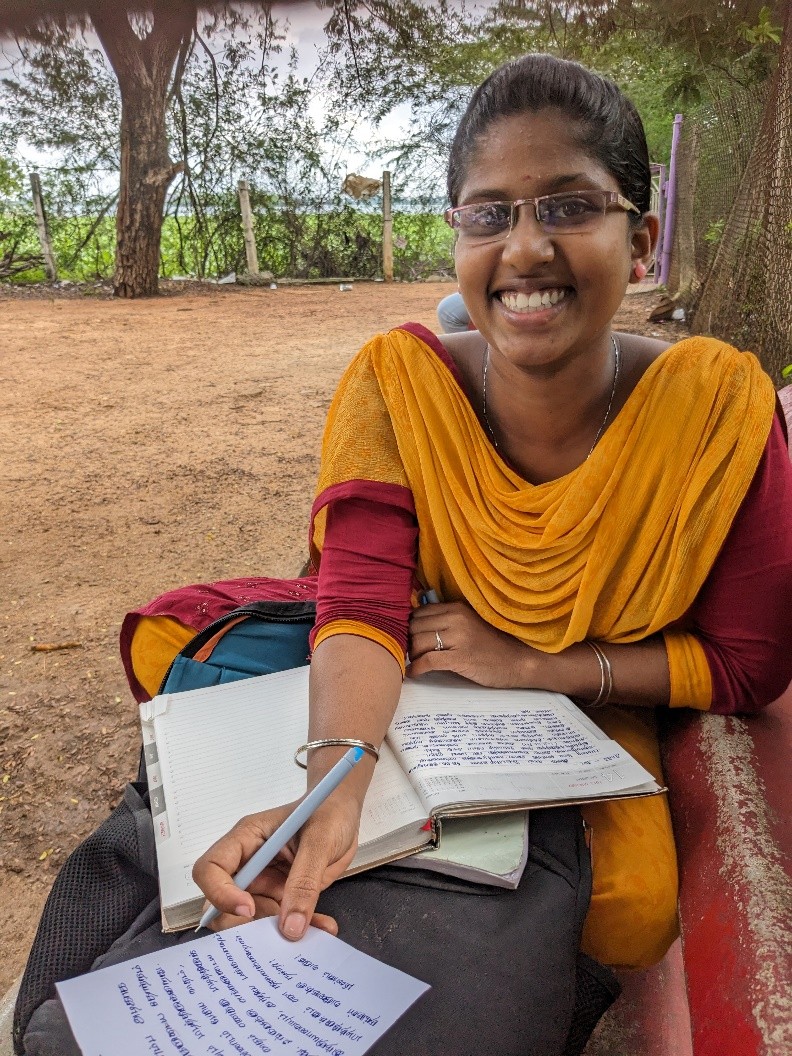
Om telephoned asking how things were. “It’s beautiful,” I said looking out of the car window at the lush palm trees and roadside vegetation. Had a sleep in the palatial hotel until 1pm and then met Om and Siddharth in the lobby. “Nice to see you again,” Om said and we started our tour. He introduced Simon the driver a Christian.
“Let it go, be simple, create a space for God,” Om advised as we drove past the colourful murals on stone walls to the sea. The sea is a God in Hinduism Shirudasau Vishnu is one of the aspects of God. We drove past the Vivikenanda Cultural Centre to the vast Marina Beach where I was welcomed by two young men with their horses ready to take me for an unwelcome gallop. There was a cool breeze and the heat was not oppressive, thank God. A dignified lady was selling fruits. A picture was fine after the purchase.
An astrologer with a green parrot sat on the sand. The parrot was let out of the cage and pulled a card out for me. The astrologer, a young man who came from a family of astrologers said I had recently sold property and recovered from a health problem. He was 100 percent right.
The cataract operation was over and my mother’s property in New Zealand had been sold. He also said I would live until 89 and my death would be an easy one. Now I would be fine in the material world even though people had taken advantage of me in the past.
Fort St George was an impressive structure built for the British regiment. It’s life continued as a large museum which housed anything and everything from the colonial days: statues of British governors including Lord Cornwallis and Lord Willingdon, porcelain, swords, manakins in army uniforms and a variety of paintings. The oldest surviving English church outside England was built in the fort in 1680.
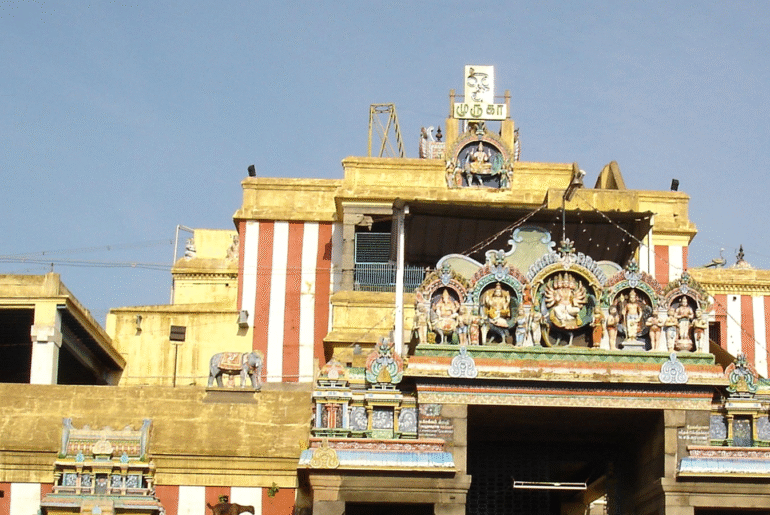
Lord Murgan Temple in Tamilnadu
Murgan, also known as Kartikeya is the son of Lord Shiva and the Goddess Pavathi. His brother is the infamous deity, Ganesha. Murgan is popularly worshipped in Southern India, especially in the Indian State of Tamil Nadu. He is often referred to as Tamil Kadavul, which means The Lord of the Tamil people. Although this sect is primarily located in the Tamil region, there are also members in Sri Lanka and Malaysia.
The handsome Kartikeya is the commander of the army of Devas (Indian deities) and is represented with six heads, enabling him to see in all directions at once. This means he can see any oncoming attack of war. He also has 12 hands and rides a peacock.
Newlyweds Lord Shiva and Goddess Parvathi lived together at Mount Gandhamadana. As they were enjoying their intimacy, a drop of Shiva’s fluid fell to the ground. Heat began to emerge from it, and it was so hot it seemed possible that it could engulf the whole world in flame. Agni (the fire god) disguised himself as a beggar, wandered in on the couple and devoured the spilled fluid in an effort to save the world.
Naturally, Parvathi was mortified and insulted at the intrusion. She cursed Agni; and said: “You are going to get a terrible inflammation on your body from consuming that fluid, and from this day on you will be an omnivore, and eat unclean things.” Agni promptly developed unbearable inflammation all over his body.
In his desperation, he asked Lord Shiva what he could do to rid himself of this awful curse. Shiva informed him that once the vital fluid was transferred to a woman, he would be relieved of his ailment.Agni hid out in a deserted place, uncomfortably awaiting a suitable woman.
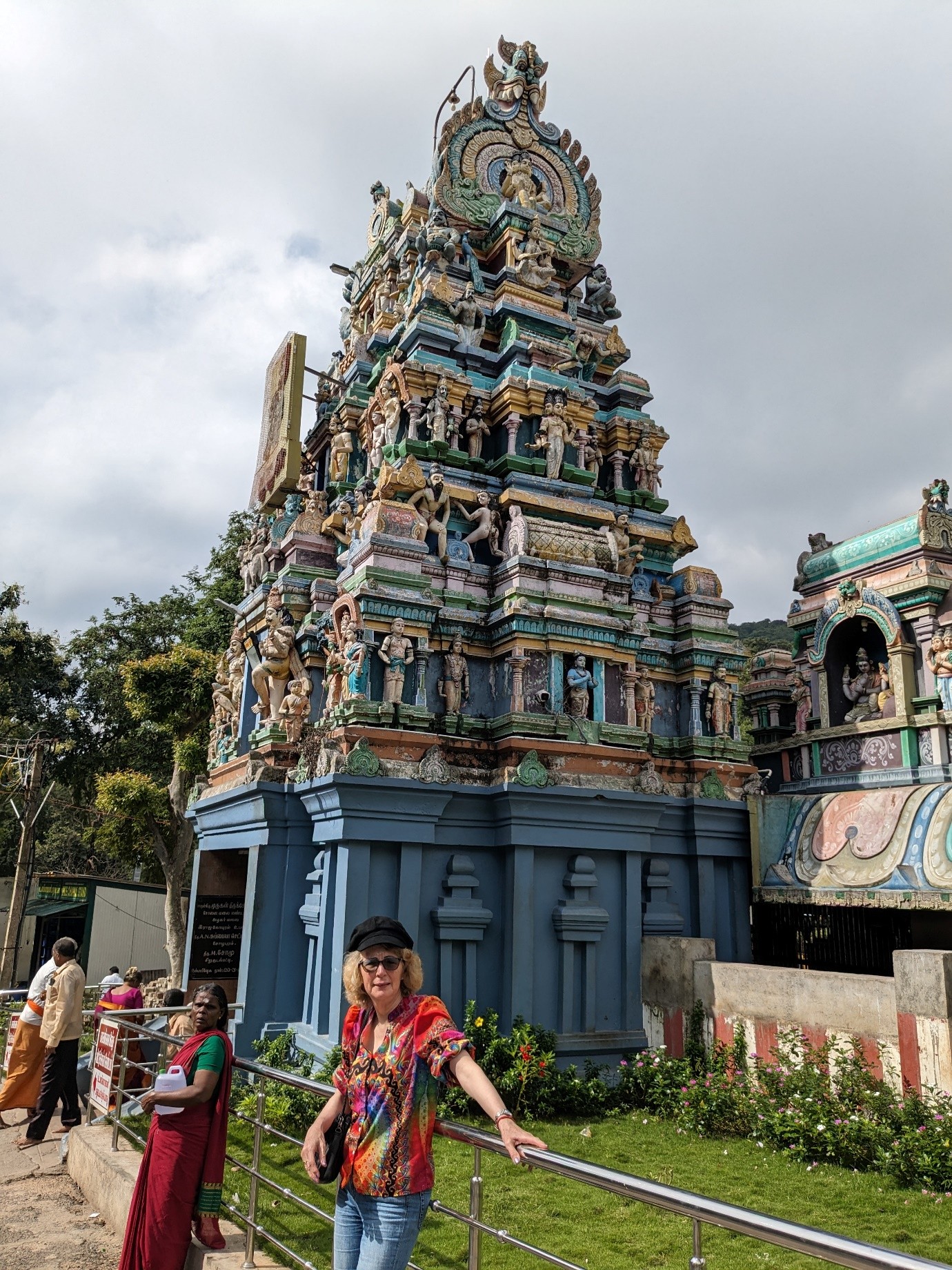
Along came the six Kritikas. He transferred the fluid into all of their wombs, and all six women became pregnant. When their husbands found out, they were cursed, turned into stars and sent to the sky to form a constellation. Before they were transformed, however, each of them aborted their foetuses on a mountain in the Himalayas. The river Ganga carried the foetuses to a secluded place covered in reeds.
After a while, Lord Murgan was born from the reeds with six heads, since he had six mothers.The gods were rejoicing at the birth of this fantastic child. Parvathi collected the baby and asked Lord Shiva to let her keep the child as her own. Murgan grew to be a handsome and honourable man and became the commander of the Devas and a great slayer of demons.
Lord Shiva, the father of Murgan, is the most powerful deity in the Hindu pantheon. He is a complex god, unique and supreme. For this reason, his shrine stands separately from the other gods in most temples.Parvathi is the representation of the furious power of the male gods, and the personification of the divine energy of Lord Shiva. She is a destroyer of evil and a protector of the righteous.
The esteemed brother of Murgan is Ganesha. He has an elephant trunk and ears, and is one of the five prime Hindu deities along with his parents. He prevails over success, destroys evil and is a remover of obstacles.
According to the legend, Murgan had two wives, Valli and Devasena. Valli stands for the power of will, and Devasena, the power of actions. Murgan represents the power of wisdom. Ironically, prior to marrying two wives, Muugan was known as Kumaraswami, which means bachelor godHe rides a peacock the national bird of India. It symbolizes the destruction of harmful habits and control over sexual desires. The peacock is often depicted gripping its feet around a serpent the symbol of ego and desire.
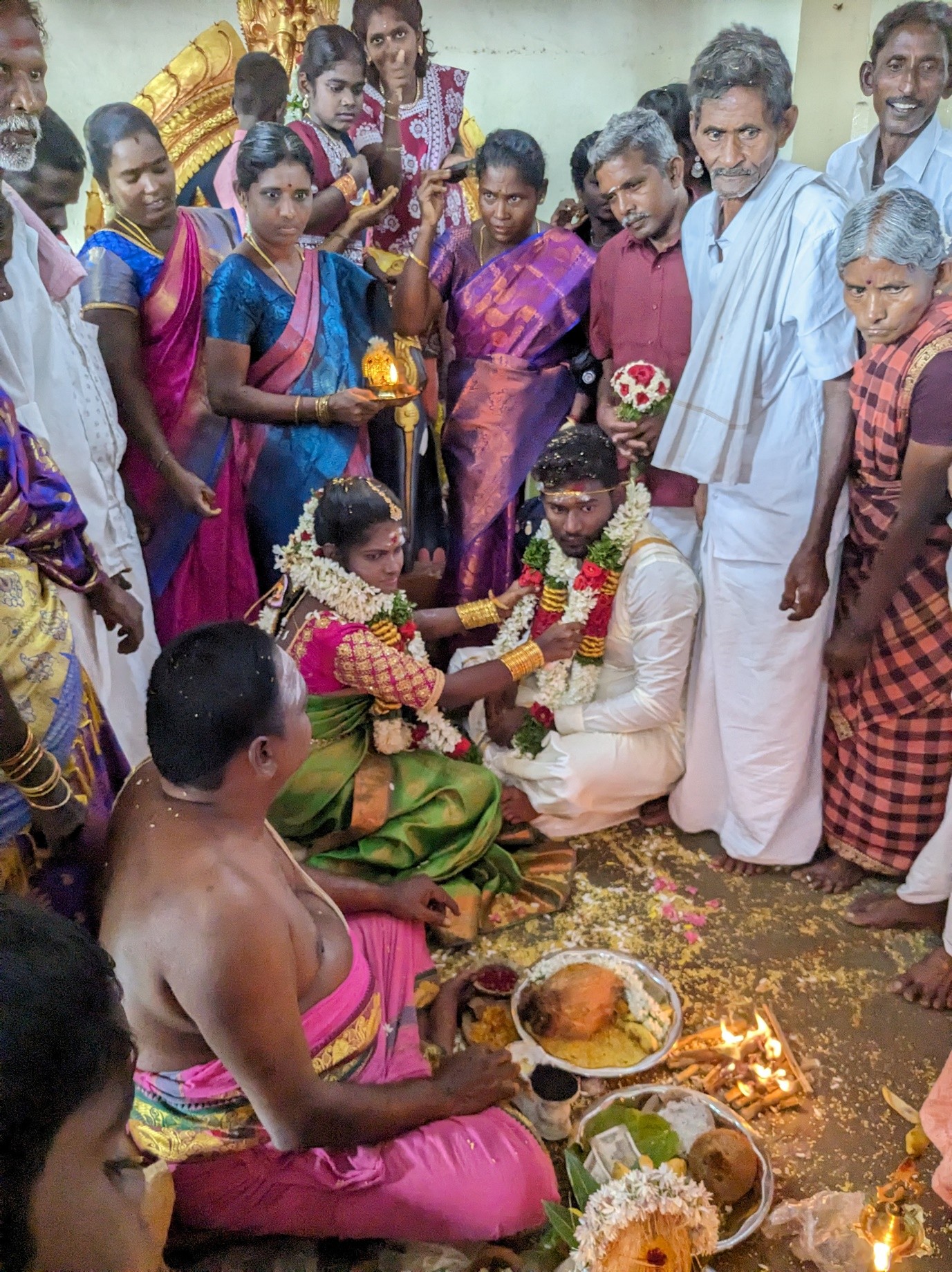
The divine spear (Vel) represents Murgan’s far reaching protection of the people. Often, Murgan is depicted holding other weapons, and each is a pointer toward a better way of life. His six heads correspond to the six attainments (siddhis) yogis aspire to along their spiritual path to enlightenment.
Several Hindu festivals are dedicated to Murgan. Thaipusam is celebrated in the Tamil community during the month of Thai, which corresponds to a time in January or February depending on the year. The festival is a celebration and remembrance of when Parvati gave Murugan the divine spear with which he slayed evil demons. – Mythology net
The tour was focused on the abodes of Lord Murgan and the first abode was the temple of Kapalaeeshwarar. It was an amazing structure just like the one I had seen in pictures. Majestically set in the Mylapore region of Chennai the Shiva Lingam in the temple is Swayambulingam, which means it is self-manifested.
The temple is also known as Vedapuri as the four Vedas are worshipped in this auspicious place. The word ‘Kapaleeswarar’ is a combination of two words Kapalam which means “head” and eswarar which means “Lord Shiva”.
The awe-inspiring architecture of the temple is a source of wonder. Visitors enter the sacred shrine through an imposing 37-metre high multi coloured tower or gopuram. The gopurams on the east and the west are adorned with numerous beautiful mythological figures.
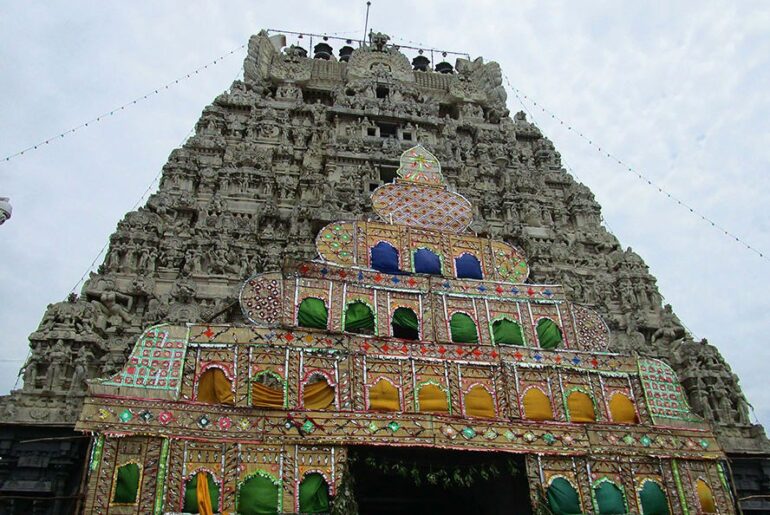
Pilgrims visiting the temple also worship Lord Shiva’s consort Parvati who appears in the form of Karpagambal. An image of a lion is located in front of the Goddess Karpagambal. An idol of the revered saint Gnanasambandar can be seen at the entrance of the temple. Other noteworthy sights include the bronze carvings of 63 Saivite saints or the Nayanars.
The temple also houses the sacred Punnai tree which is believed to be one of the oldest trees of Chennai.
The lights in front of the altar beckoned but a sign that non Hindus could not enter dashed my hopes of getting close to the sacred flames. Tried talking to the security guard and telling him that I was a devotee of Hanuman and that the message of Krishna was not just for the Hindus but for all of humanity. He seemed to agree but didn’t manage to get into the temple. The only way you can get in, according to the guard, was to bring a letter saying I was a convert to Hinduism.
Back at the hotel wrote an email to Acharya Bankim Gossai head of the Maha Lakshmi Vidya Bhavan in Honor Oak Park south east London:
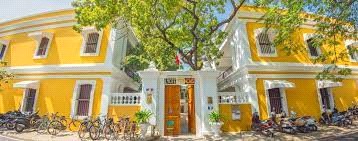
Namaste Ji,
I hope this message finds you well. Arrived in Chennai and started the temple tour. India is a really magical place and the city is really beautiful Also the beach.
Sadly there is a problem with the temples. They do not allow non Hindus inside. There are big red signs in some temples and there is a guard outside not so politely telling foreigners to stay in the courtyard.
I am totally gob smacked by this – it never happened in the north. I tried totell the guard that I lovethe Hindu religion, I attend pujas in London and consider myself a devotee of Hanuman. He said the only way to gain entry is to bring a letter saying I am a convert to Hinduism
To be quite honest I do not like labels. Why put yourself in a box and then try to fit the shape of that box? I am learning about Hinduism and it is a philosophy and way of life that resonated with me. Does that make me a Hindu? From my understanding Hinduism is a spiritual journey to enable you to be the best possible person you can be.
This comes through daily effort and meditation and study. It is something that you experience more and more. The journey is between you and God and your relationship with the supreme being.
It really hurts me to see these signs at the entrance to the temple. The message of Krishna and the Gita is a message for all humanity just like the messages of all the great masters.
In a temple in London I read the following: there is only one religion, the religion of love there is only one race the human race, there is only one law, the law of karma.
So what to do now? The tour is a tour of the temples of Lord Murgan. I am not there to
take photos like a tourist, post on face book and mark south India off the bucket list. Really want to see and experience the beauty and inspiration of these temples and sit quietly and be at peace there.
If you think it’s appropriate could you write a letter which might help in English and Tamil.
Or what is your advise about what to do in this situation?
Gosai really rose to the occasion and did me proud. On my email the next day was the following letter. It didn’t get me into the temples. The letter, according to the bureaucrats, had to come from a temple in South India. How do they expect me to get a letter from such a temple when I have just arrived from London only God knows.
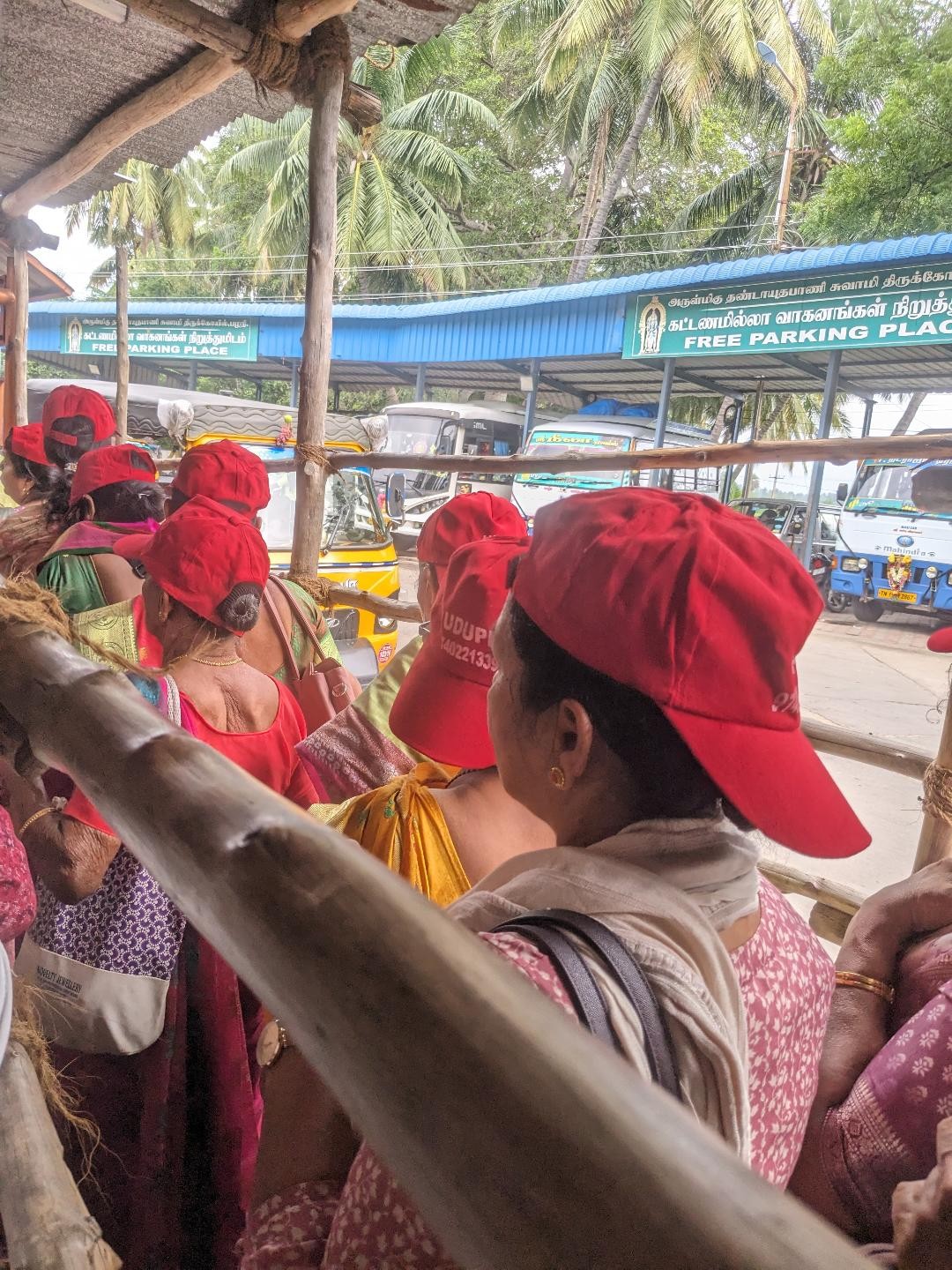
TO WHOM IT MAY CONCERN
Dear Sir/Madam Karen Dabrowska is a member, devotee, sevak, and attendant of Maha Lakshmi Vidya Bhavan in London UK. As a practising Hindu, she fulfils her devotion, loyalty, and duty to Sanatan Dharma. She is loved and well respected in our Hindu Community in London and the United Kingdom at large for her dedication and love for Sanatan Dharma and her Eshta Sri Hanumanji.
Her accomplishments as a journalist have also allowed her to serve our community by spreading knowledge, awareness, and her love for Hinduism across the UK and the world. It has come to our attention that her yatra to India is marred by restrictions when it comes to her entering temples in the South.
It is our humble appeal to the authorities and management of these temples that banning entry by non-Hindus is not right and proper in the Hindu world, and therefore, you should open the gates of Sanatan Dharma and ALL temples to everyone.
Karen is an exceptional individual whose thirst and desire to learn and appreciate this way of life is growing with a desire to spread the tenets of Hinduism and gain a better understanding, like us all, of our temples and ways of worshipping.
On behalf of our temple members as well as all the members of the Hindu community which Karen is connected with, in the United Kingdom, we appeal for your leniency and cooperation to facilitate access to your temples by this humble devotee on her Bharat Yatra. Please be reminded that the children of India are vastly dispersed in many countries of the world.
Yours in Dharma
Acharya Bankim Gossai
(Spiritual Head – Maha Lakshmi Vidya Bhavan, London)
23rd November 2023 – Thursday
Chennai to Pondicherry
Thiruthani Temple in Kanchipuram, Kamakshi Amman Temple, Mahabalipuram UNESCO World Heritage site.
We are on the road by 6am It is a long drive and Simon was very worried I would not get up in time. Everything was packed the night before and he was a bit late. The first temple today was Thiruthani in Kanchipuram. Forgot to take the packed breakfast which the hotel prepared for me but the coconut water bought along the road side more than compensated for this. The top of the coconut fresh off the tree was sliced and a straw provided. The water could then be easily sipped.
It was interesting reading about the temple with 365 steps for the 365 days of the year. Was looking forward to climbing the steps but it was not to be. Simon parked the car by the temple entrance and the steps could be contemplated but not climbed.
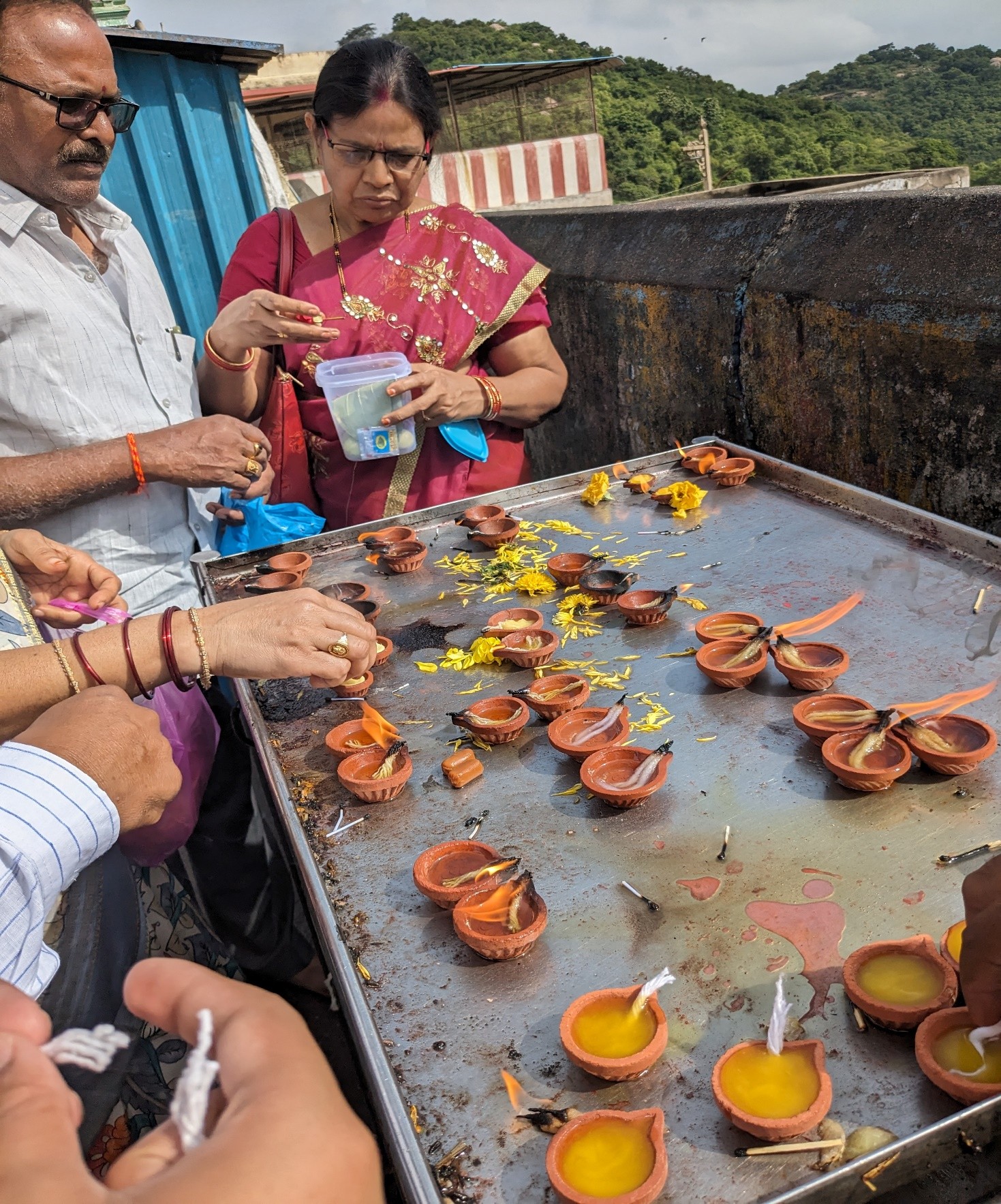
The Thiruthani MurganTemple one of the six abodes of Lord Murgan is in the Dravidian style of architecture. Its 365 steps represent 365 days of the year. It crowns a single rock 700 feet above sea level situated amidst a range of hills which showcase a dramatic panoramic view.
The stories associated with the temple are as bewildering as the temple itself. One legend states that Murugan chose to rest atop the hill to calm himself down in the aftermath of the battle with the demon king Surapadman which resulted in latter’s demise.
Another legend states that Indira, the lord of heaven, gave a nod to the marriage between his daughter Devayani and Murgan and as a gift, handed him over his elephant Airavata. Gradually Indra began to notice his wealth decline days after Airavata left. Murgan offered to return the elephant but was respectfully declined by Indira who instead insisted that the elephant should face his direction. All the images of the elephants in the temple have been facing east to this day.
The next temple was Kasmakshi Amman Temple, another temple where non Hindus are not allowed into the inner sanctum. Had a chat with the security guard and asked him if the message of Krishna was just for the Hindus. He has to agree that it was in fact for all people and did not answer when I told him I was a devotee of Hanuman.
To get into a temple a letter stating I am a convert to Hinduism was necessary. Their words. .Never regarded myself as a convert to Hinduism which I see as a journey rather than an event. There were important dates and times on this journey: the reading of Autobiography of a Yogi, the visit to Baba Ji’s cave in Ranikent, the discovery of the Vashishtha cave near Rishikesh. An amazing journey of discovery.
The Kamakshi Amman Temple represents an important gem from the past. Set in the midst of Kanchipuram, also known as the City of Temples, this place of worship is home to the divine Goddess Kamakshi, who is believed to be an incarnation of Parvati, the Hindu goddess of love, fertility and strength.
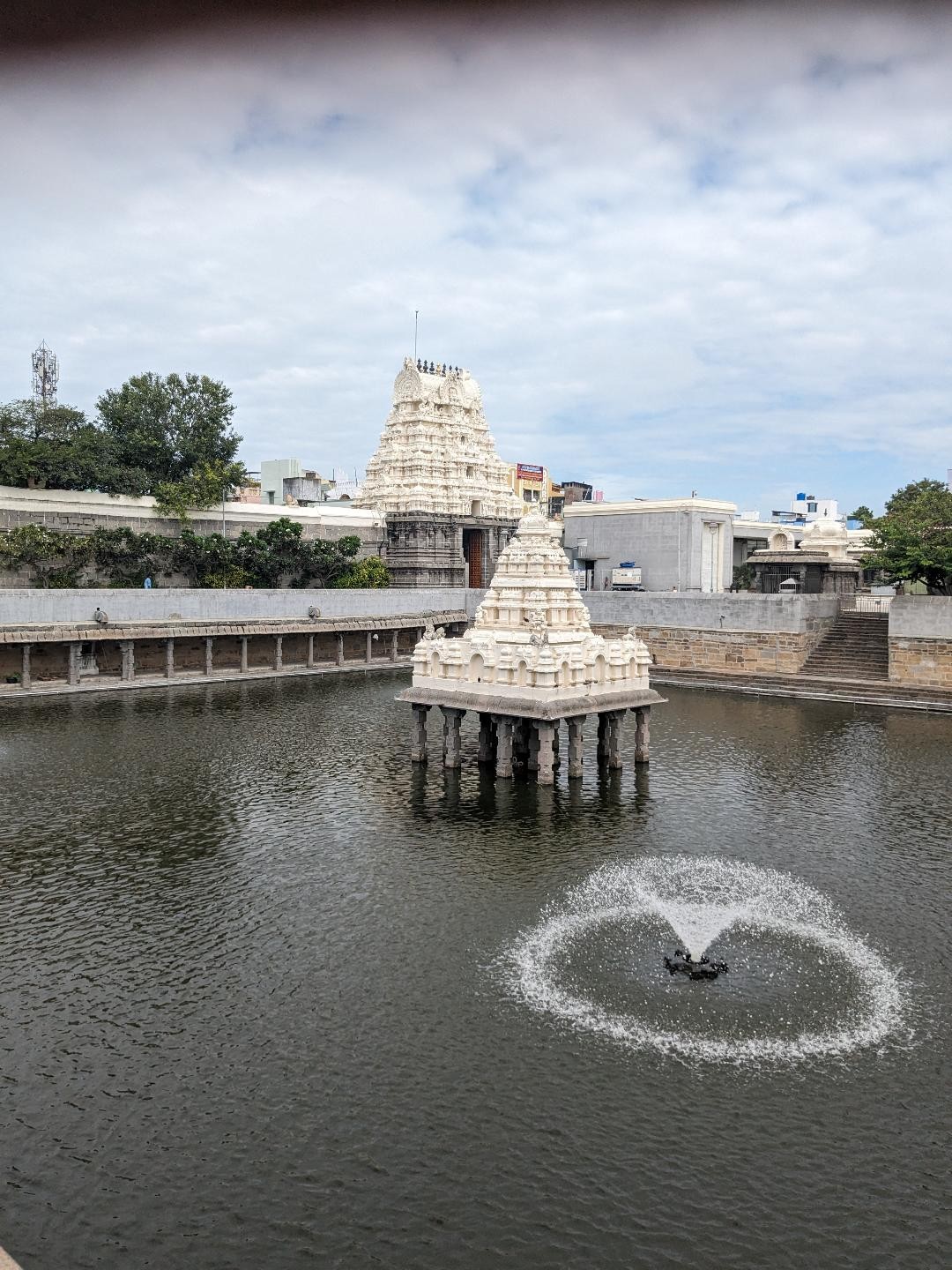
The Kamakshi Amman temple is one of the 51 Shakti Peethas, sacred shrines built around the falling body parts of the corpse of Goddess Sati which fell from heaven. It is believed her naval fell at this site, thus making it a holy abode. Shaktism is based on a Hindu tradition focused on worshipping Sati.
In the name Kamakshi, the letter ‘Ka’ represents Saraswati (the Goddess of knowledge and wisdom), ‘ma’ represents Lakshmi (the Goddess of wealth and prosperity), while ‘akshi’ refers to gracious eyes. Together, these three Hindu goddesses or devis form the holy trinity of the female transcendental energy of the universe.
Om and Sidharth lit candles: for Anju and for Thushita. I lit one for Raghav who asked me to pray to all the gods I know for success in his Ayurvedic business and for Len and visualized the faces of the friends in London and sent them blessings. We were also treated to a brief glimpse of a Hindu wedding and then off we went to Mahabalipuram a UNESCO World Heritage site known for its rock cut temples and sculptures.
The beach town of Mamallapuram (or Mahabalipuram), located about 60 kilometres south of Chennai, has long been a famous tourist destination, and its global appeal has grown since UNESCO designated the ancient complex of monuments a World Heritage site in 1984.
Mahabalipuram (or Mamallapuram), located along southeastern India’s Coromandel Coast, was a celebrated port city of the Pallavas. The group of monuments there consists of rock-cut cave temples, monolithic temples, bas-relief sculptures, and structural temples as well as the excavated remains of temples. The Pallava dynasty, which ruled this area between 6th and 9th centuries CE, created these majestic edifices.
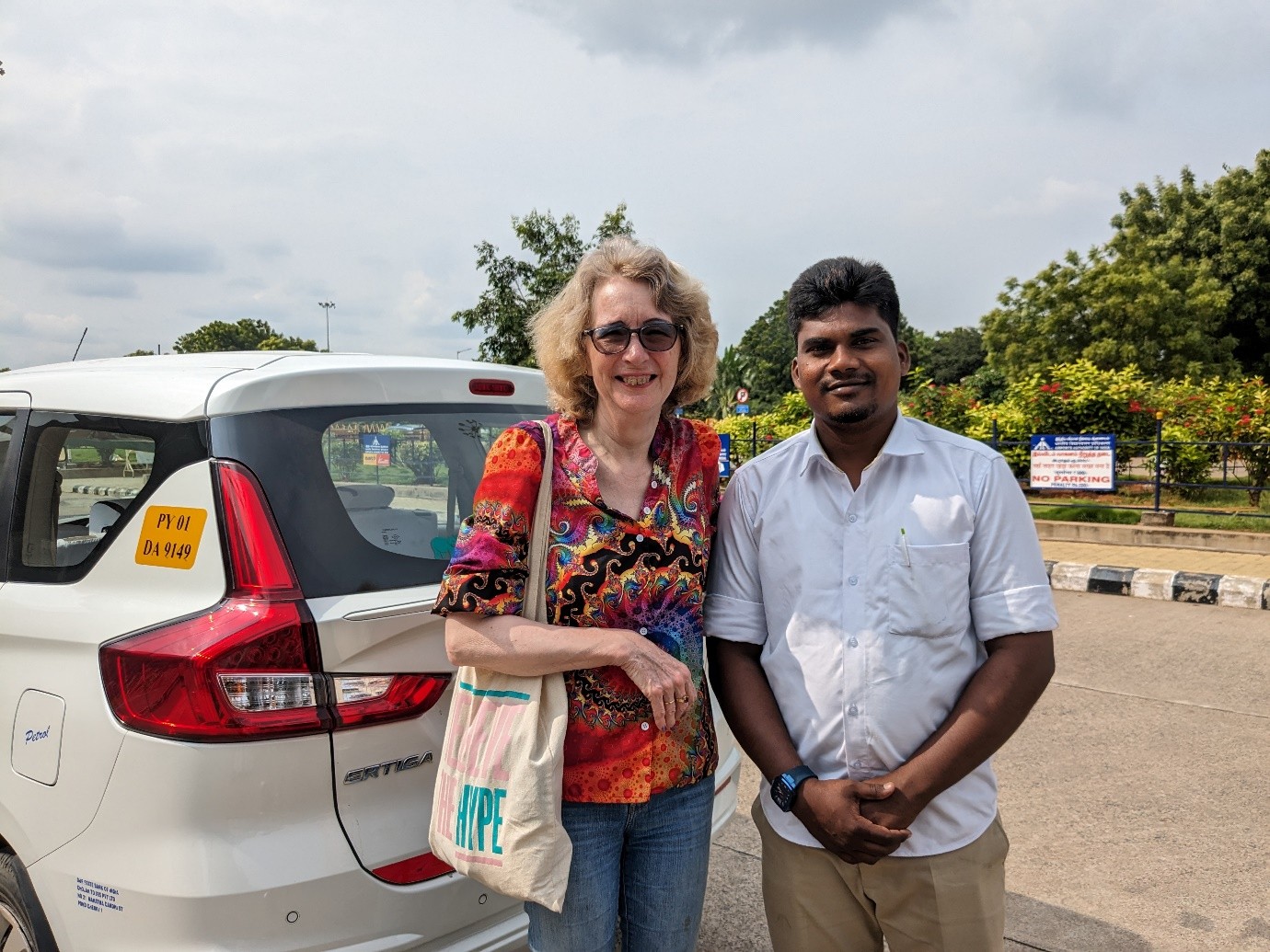
The Group of Monuments at Mahabalipuram occupies a distinct position in classical Indian architecture. These majestic edifices mark the high quality of craftsmanship in the region during 6th century CE. The natural landscape was utilized in carving out these structures, thereby making the ability of the Pallava craftsmen universally known. The monuments may be subdivided into five categories:
The mandapas (rock-cut caves): During the time of Narasimhavarman-I Mamalla, new innovations were introduced in the rock medium in the form of cave temples. Notable examples of the cave temple are Konerimandapa, Mahishmardhini cave, and Varahamandapa.
These rock-cut caves are richly embellished with sculptural representations known for their natural grace and suppleness. Noteworthy among them are Mahishamardhini, Bhuvaraha, Gajalakshmi, Tirivikrama, and Durga.
The rathas (monolithic temples): The monolithic temples are locally called “ratha” (chariot), as they resemble the processional chariots of a temple. These five monolithic temples are each hewn out of a huge boulder. They display the full form and features of the contemporary temple form and show variations both in ground plan and elevation. They are richly carved with artistic motifs and wall panels depicting many Hindu divinities and royal portraits.
The rock reliefs: The sculptural bas reliefs are another very important class of masterly creations created during Mamalla’s reign. There are four such reliefs at Mamallapuram, the most noteworthy among them being the Arjuna’s Penance and Govardhanadhari.
The temples: King Rajasimha introduced structural architecture on a grand scale. The earliest and most modest is the Mukundanayananar temple, followed by the Olakkanesvara temple, perched on a rock near the lighthouse. The tempo of structural edifices culminated in the creation of the famous Shore temple, having the most finite layout of a Dravidavimana, majestically fringing the sea.

Friday 24th November
Pondicherry to Kumbakonam
Pondicherry is a place that looks a lot better in pictures than in reality. It was a French colonial settlement in India until 1954 and is now a Union Territory town bounded by the south eastern Tamil Nadu state. Its French legacy is preserved in its French Quarter, with tree-lined streets, mustard-coloured colonial villas and chic boutiques. A seaside promenade runs along the Bay of Bengal and passes several statues, including a 4m-high Gandhi Memorial. It is known for its quaint colonial buildings, beautiful promenades, unspoilt beaches and many temples.
The French Quarter
A portion of France still exists in India in the French Quarter in Pondicherry, which has a history of being acquired and colonised by the French East India Company to set up a trading centre. Pondicherry had been passed on to multiple colonial powers of Dutch, Portuguese, English, but predominantly French.
Even now there’s a huge French influence in the French Colony of Pondicherry, now a Union Territory of India. When Pondicherry was handed over to India, the residents were given an option to maintain their French passports. The residents (Indians and non-Indians originally) in Pondicherry are French citizens, the streets have retained their French names, the residents speak French, there are restaurants and cafes serving French food with menus in the French language and the villas in French architectural styles prevail.
Pondicherry is planned according to the French grid structure and has perpendicular streets. The French Quarter lies on one side of the canal that separates the town from the Indian Quarter. The Heritage Walk in the French Quarter of Pondicherry is through the primary four streets: Rue Duman, Rue Romain Rolland, Rue Suffren and Rue La Bourdonnais.
We started with a walk along the beach. Om and Sidharth said a prayer to the sea while I gave a charming young man selling very very pink candy a few rupees. The boy was respectful and did not ask for money. Simon wanted to show me the light house but Om asked why the lighthouse.
There seemed to be some disagreement between them and Simon said he was responsible for the tour. I explained to him that we do not have to follow the programme exactly and I would like to have a good look at a few things rather than keep to the full programme exactly. Simon was looking at Om as a tour guide rather than a person on the tour and I could sense his unease.

We drove on to the Sri Aurobindo Ashram. Sri Aurobindo (pictured below) was an Indian philosopher, yogi, maharishi, poet, and Indian nationalist. He was also a journalist, editing newspapers such as Vande Mataram.
The Ashram is located in the eastern part of Pondicherry. Ashram residents live and work in a number of buildings spread throughout the area. The focus of community life is the Ashram main building, usually called simply “the Ashram”, which consists of an interconnected block of houses, including those in which Sri Aurobindo and the Mother lived for most of their lives.
At its centre, in a tree-shaded courtyard, lies the Samadhi, a white marble shrine where their bodies are laid to rest. The Ashram provides its members with what they need for a healthy life. Various departments look after the basic requirements of food, clothing and shelter, as well as medical care.
There are also libraries for study and facilities for a variety of cultural pursuits including music, dance, theatre, and the arts. Residents regularly participate in physical education activities such as sports, asanas, strength training, and swimming. The Ashram is administered by the Sri Aurobindo Ashram Trust, a public charitable trust formed by the Mother in 1955. This trust is managed by a board of five trustees. The term ashram is perhaps a misnomer. It is more of a small community set in the idyllic countryside.
The coconut water was a joy as we walked from the car park to the dome which we could not get close to unless we booked two days in advance. Om in his monk-like attire was respected by the tourists who spoke to him as if he was a spiritual authority. There was some discussion about entry to the dome and the necessity to book. We took a bus back to the car park. The sweat was starting to pour down my body and the walk was something I could only manage once.

Chidambaram
Chidambaran is a town and municipality in Cuddalore district in the Indian state of Tamil Nadu on the banks of the Vellar River where it meets the Bay of Bengal. Chidambaram is one of the many temple towns in the state which is named after the groves, clusters or forests dominated by a particular variety of a tree or shrub and the same variety of tree or shrub sheltering the presiding deity. The traditional name of the temple complex is Chidambaram Thillai Nataraja-koothan Kovil.
The mangrove forests of Thillai trees were abundant in the town once. The temple and the town were once in the midst of Thillai trees. The Thillai trees of the nearby Pichavaram wetlands, the second largest mangrove forest in the world, extends to the temple area.
The shrine is venerated as Thillai ambalam literally meaning the open stage of Thillai. The name of the town of this shrine, Chidambaram comes from the Tamil word Chitrambalam (also spelled Chithambalam) meaning “wisdom atmosphere”. The roots are citta or chitthu means consciousness or wisdom while and ambalam means “atmosphere”. This composite word comes from its association with Nataraja (Shiva), the cosmic dancer and the cultural atmosphere for arts.
According to Hindu legend, in the Thillai forests resided a group of sages who believed in the supremacy of magic — that the gods could be controlled by rituals and mantras. Shiva hearing this, assumed the form of Bhikshatana a simple mendicant seeking alms, and went walking in Thillai. He was followed by his consort, Vishnu. The sages and their wives were enchanted by the beauty of the pair.
On seeing their womenfolk enchanted, the angry sages performed a ritual to create serpents (nagaas) Shiva lifted the serpents and donned them as ornaments on his matted locks, neck and waist. Further enraged, the sages invoked a fierce tiger, whose skin was used by Shiva as a shawl around his waist.
Then followed a fierce elephant, which was ripped to death and devoured by Shiva. The sages gathered all their spiritual strength and invoked the powerful demon Muyalakan — a symbol of complete arrogance and ignorance. Shiva smiled gently, stepped on the demon’s back to immobilise him, and performed the Ánanda Thandavam (the dance of eternal bliss), thus disclosing his true form. The sages surrendered, realizing that rituals cannot control the gods.
Chidambaram Natarajar Temple is dedicated to Lord Shiva.The temple is 78 km south of Pondicherry and 235 Km from Chennai, the capital of Tamil Nadu.The temple complex proudly boasts being one of the oldest temple complexes in southern India. The most unique characteristic of the Nataraj Temple is the bejewelled image of Nataraj, Shiva as the cosmic dancer. The temple has five main halls.
It was a large temple complex. After visiting two of the temples Om, Sidharth and me sat on the grass and looked up at the massive structures. The weather was warm but not oppressively hot. The love between Om and Sidharth was touching as they smiled at one another and lay on the grass together.
Kumbakonaum is an idyllic town skirted by Cauvery and Arasalar rivers. Popular as a temple town, Kumbakonam is home to around 188 temples, the most prominent of which is the Kumbeswarar Temple. Dedicated to Lord Shiva, it is the oldest shrine in the area, built in the 7th century.
The highlight of this temple was the elephant. It touched devotees on the head with its trunk and then takes the donations and places the rupee notes in a tray. Two men were busy grating carrots for the elephant with the symbols of Shiva painted on his body.
Saturday 25th November
Swamimalai Village and temple
Swamimalai is situated about five kilometers west of Kumbakonam on the banks of a tributary of river Cauvery.
It is the fourth among sacred shrines dedicated to Lord Muruga. The presiding deity here expounded the meaning of the Pranava mantra OM to his own Father Lord Siva Himself.
Mythology says that saint Bhrugu before commencing an arduous tavam or penance, got the boon that anybody disturbing his mediation will forget all his knowledge. Such was the power of the penance that the sacred fire emanating from the head of the saint reached up to the heavens, and the frightened devas surrendered to Lord Siva praying for his grace.
The Lord extinguished the sacred fire by covering the saint’s head by hand. With the saint’s penance thus disturbed the Lord became oblivious of all his knowledge and is said to have regained it by learning the Pranava mantra from Lord Muruga at this shrine.
Once when Brahma, the lord of all creations was proceeding to Kailasa, the ever-playful child Lord Muruga asked him for the meaning of the Pranava OM. When Brahma admitted his ignorance, the Lord imprisoned him. With Brahma imprisoned, all creations came to a standstill and the devas prayed to Lord Siva to get Brahma released.
When Muruga insisted that the imprisonment was a just punishment for the ignorance of Brahma, Lord Siva asked him whether he himself knew the meaning of the primordial Pranava OM. Lord Muruga said that he knew the meaning of OM and could expound it to the latter only if he accepted him as guru and listened to the exposition as a devoted disciple. As Lord Siva acceded to the request of Lord Muruga and heard the exposition of OM as a disciple, the place came to be known as Swamimalai and the presiding deity as Swaminathan.
The temple is built on an artificial hillock of about sixty feet height with sixty beautifully laid stone steps representing the Hindu cycle of sixty years leading to the Lord . In the ground floor there are temples dedicated to Lord Sundareswarer and the Goddesss Meenakshi.
Sunday 26th November
LONG DRIVE TO MADURAI, VISHNU TEMPLE, MAGICAL FULL MOON
Another long drive with an early start. It was easy getting up at 5am and was once again convinced me of the benefits of rising early and sleeping early.
It was a long drive to Madurai with a most welcome stop by the side of the road and an ice cream which I bought for everyone. Simon kept his distance but was grateful for the ice cream. A good driver he seldom spoke but was always good natured and welcoming. It was on the (Left: Author with Simon Joshua the driver. Below: On the road to Madurai)
We stopped at a café where had the chance to practice some tai chi. The
looked on with interest as did Om and Sidharth. Do not travel well at all and the long car ride really tired me out. Slept some of the time and strained my neck.
Madurai
Madurai is an energetic, ancient city on the Vaigai River in the South Indian state of Tamil Nadu. Its skyline is dominated by the 14 colorful gopurams (gateway towers) of Meenakshi Amman Temple. Covered in bright carvings of Hindu gods, the Dravidian-style temple is a major pilgrimage site. Millions attend the processions and ceremonies of April’s Chithirai Festival celebrating Meenakshi and Lord Vishnu.
Located on the banks of the river Vaigai, Madurai has been a major settlement for two millennia and is one of the oldest continuously inhabited cities in the world. This city was the capital of the Pandyan kingdom – initially at Korkai, around 600 BCE and later moved to Koodal (the present Madurai) during the reign of Nedunj Cheliyan I.
Madurai is famous for its temples built by Pandyan and Madurai Nayak kings in the Dravidian style of architecture. It is also one of India’s most outstanding Hindu pilgrimage centres. Madurai is also called City of Junctions (Koodal nagaram), City of Jasmine (Malligai maanagar), Temple city (Koil maanagar), City that never sleeps (Thoonga nagaram) and City of four junctions (Naanmada koodal).
The last days of the tour were spent in Madurai visiting more fascinating temples. The visits were great but the long queues in the hot sun were not at all enjoyable.
Monday 26th November, Tuesday 27th November
Palani Murgan Temple, Monkey temple
It was quite a long but pleasant drive to the Palani Murgan Temple. We travelled along a broad road – you couldn’t really call it a highway but it was quite a decent road with lush green vegetation on either side.
We stopped at a road side cafe (dhabba). There was a pleasant tea shop with a variety of snacks and Indian sweets and a beaming, confident man selling coconut water. He looked at me with great curiosity and I returned the gaze with equal curiosity. Om ordered a coconut which was expertly decapitated and a straw provided to drink the delicious sweet water.
Needed to go the toilet and the facility was European, thank God. Outside the toilet I heard two women talking. One had a baby and the newcomer grabbed the baby and said “tourist coming.” She brought the baby to me as I was drinking my coconut water and kept saying “mother give money.”
Another money making scam. The mother was quite content to sit with her baby obviously enjoying the time with the infant. The other woman was out to make a few easy rupees but no such luck with me.
There was a welcome tea after the coconut water which I was very happy to buy for everyone. Time passed quickly and all too soon we had to move on.
In theory the temple is reachable by cable car but the reality was somewhat different – and confusing. At first we waited in a queue which supposedly led to the cable car but then realised that the cable car was not working for at least another two hours.
So we changed locations to another cable car by taking a horse drawn cart. No luck at the second cable car either and ended up climbing up the concerted hill with steps and lots of toilet stops.
On the way to the temple the view of the town below was amazing. Trees and flowers lined the path to the temple and there were a number of welcome seats. We reached the top of the hill and sat on the steps before the entrance to the temple. A small shrine with its burning fire welcomed us as we rested.
The wait to go inside was not to long but as in most temples it was just a matter of filing past the god with a black face and getting a tilaka on the forehead.
Lord Murugan is the deity of the Tamil Land. The temple at Palani is an ancient one, situated at an elevation of 1500 feet above sea level. The deity of Palani is known as Dandayudhapani Swami, the Lord having the Staff in his Hand. The deity at the sanctum sanctorum is made out of an amalgam of nine minerals popularly called Navabashana.The deity is in a standing position with a baton in his hand.
He has the look of a person who has renounced all worldly pomp. He has just a loincloth besides the baton. He is a mute messenger of the great precept ‘Renounce all to reach Me’. The icon is unique in the whole world. It was made by Siddha Bhogar by combining nine poisonous substances (navabashana). Murugan signifies beauty and Lord Murugan of Kurinji land is the god of Beauty and Youth.
There is a legend how Lord Murugan came to this sacred spot. Narada Muni, a sage, brought a golden mango to the divine court of Lord Siva when Lord Siva was seated with his consort Parvati and his children Lord Vinayakar and Lord Subrahmanya.
Narada gave the fruit to Lord Siva and implored im to eat since it was a rare, miraculous Jñanapalam, the fruit of wisdom. As a loving husband, Lord Siva gave it to Parvati and requested her to eat. As a loving mother, she wanted to give the fruit to her children. As there was only one fruit and it should not be cut, they announced a contest and said that the winner would be given the fruit. Whoever completes one round of the globe first will be given the fruit.
Lord Subrahmanya mounted his peacock to go around the world. Lord Vinayakar circumambulated around his parents, symbolising the world, and got the fruit. On return, Lord Subrahmanya found that he was cheated. In anger, he renounced his family and came to this spot to settle forever. Lord Siva and Parvati came to pacify Him. They said, “Pazham Nee” (‘You are the Fruit’). Hence the name Palani is a popular syncopation of the two words mentioned.
The presiding deity, Lord Dandayudhapani Swami, is the son of Lord Siva and son-in-law of Vishnu. Murgan is worshiped cuts across provincial boundaries and national frontiers and people from all over the world come too this temple on their spiritual journey.
Cheaman Perumal, a ruler of Kerala, built the main temple in the 7th Century AD. The Nayaks built the Navaranga Mandapam which is a fascinating stone structure incorporated by four pillars and is endowed with nine bays. The other portions of the temple have been built by the Pandiya kings, besides a number of local leaders religious groups and individual devotees.
The visit was not without its adventure. A cheeky monkey took my coke bottle out of my hand and drank most of it.
The visit ended as it began with sitting on the steps at the entrance to the temple, admiring the view and soaking up the atmosphere. Going down was harder on the legs than going up. The drive back to Maduri was magical with a full moon lighting the way and sending some powerful energy of peace and contentment.
On the last day in Maduri before driving to the airport we visited another temple and the local market and a large park.
(Left: Monkeys in the car park next to Palani temple. Below: shopping in Maduri).
Went to a shop which was allegedly the only Hindu shop in the street. Guessed the shop keeper sensed my interest in Hinduism. Bought a large Om sign mindful that money had to last for the trip to New Zealand after this short stop South India.
There was some time to kill before the flight to Delhi. We sat in a large park which was being extended. A delightful young lady busy with her studies spoke to me and asked me about London. Asked her to write something for me in Tamil and she obliged.
Treasure this piece of paper welcoming me to Tamil Nadu. It was not such a long drive. to the small airport. For some reason had to unpack my large suitcase. Om took it all in good grace and helped me. He was also very generous buying me cups of coffee. South Indian coffee is sweet and lovely to taste. Learned how to pour the coffee in the saucer to cool it down. One thing I became quite an expert at in Tamil Nadu.
There was a three hour wait in Bangalore. Here the airport was modern and busy. More cups of coffee and Sidharth good naturedly carried my pack. The flight was close to midnight and we arrived in New Delhi in the early hours of the morning.
The plan was for Anju to join me in the Seasons Hotel in Delhi but she decided not to come. Om and Sidharth came with me to Le Season Hotel. The driver would then take them to the railway station for the journey back to Rishikesh. The driver from Memorable India, Shyam Yadav a charming young man was waiting for us at the airport and Om nudged me to give him a tip. Well deserved for turning up at this late hour.
My room in Le Seasons was a lot nicer than the previous one. Slept until the afternoon in the evening went for a short walk in the street outside the hotel. Sightseeing in Delhi would be te next day.
A wonderful trip and a great insight into the temples of the south. All good except for the queues.
Murgan Temples in Tamilnadu Murgan Temples in Tamilnadu Murgan Temples in Tamilnadu Murgan Temples in Tamilnadu Murgan Temples in Tamilnadu Murgan Temples in TamilnaduMurgan Temples in Tamilnadu Murgan Temples in Tamilnadu Murgan Temples in Tamilnadu Murgan Temples in Tamilnadu Murgan Temples in TamilnaduMurgan Temples in TamilnaduMurgan Temples in Tamilnadu Murgan Temples in Tamilnadu Murgan Temples in Tamilnadu Murgan Temples in TamilnaduMurgan Temples in Tamilnadu Murgan Temples in Tamilnadu Murgan Temples in TamilnaduMurgan Temples in Tamilnadu Murgan Temples in Tamilnadu Murgan Temples in Tamilnadu Murgan Temples in Tamilnadu Murgan Temples in Tamilnadu Murgan Temples in Tamilnadu Murgan Temples in Tamilnadu Murgan Temples in Tamilnadu Murgan Temples in Tamilnadu Murgan Temples in Tamilnadu Murgan Temples in Tamilnadu Murgan Temples in Tamilnadu Murgan Temples in Tamilnadu Murgan Temples in Tamilnadu Murgan Temples in Tamilnadu Murgan Temples in Tamilnadu Murgan Temples in Tamilnadu Murgan Temples in Tamilnadu Murgan Temples in Tamilnadu Murgan Temples in Tamilnadu Murgan Temples in Tamilnadu Murgan Temples in Tamilnadu Murgan Temples in Tamilnadu Murgan Temples in Tamilnadu Murgan Temples in Tamilnadu Murgan Temples in Tamilnadu Murgan Temples in Tamilnadu Murgan Temples in Tamilnadu Murgan Temples in Tamilnadu Murgan Temples in Tamilnadu Murgan Temples in Tamilnadu Murgan Temples in Tamilnadu Murgan Temples in Tamilnadu Murgan Temples in Tamilnadu Murgan Temples in Tamilnadu Murgan Temples in Tamilnadu Murgan Temples in Tamilnadu Murgan Temples in Tamilnadu Murgan Temples in Tamilnadu Murgan Temples in Tamilnadu Murgan Temples in Tamilnadu Murgan Temples in Tamilnadu Murgan Temples in Tamilnadu Murgan Temples in Tamilnadu Murgan Temples in Tamilnadu Murgan Temples in Tamilnadu Murgan Temples in Tamilnadu Murgan Temples in TamilnaduMurgan Temples in Tamilnadu Murgan Temples in Tamilnadu Murgan Temples in Tamilnadu Murgan Temples in Tamilnadu Murgan Temples in Tamilnadu Murgan Temples in Tamilnadu Murgan Temples in Tamilnadu Murgan Temples in Tamilnadu Murgan Temples in Tamilnadu Murgan Temples in Tamilnadu Murgan Temples in TamilnaduMurgan Temples in Tamilnadu Murgan Temples in Tamilnadu Murgan Temples in Tamilnadu Murgan Temples in Tamilnadu Murgan Temples in Tamilnadu Murgan Temples in Tamilnadu Murgan Temples in Tamilnadu Murgan Temples in Tamilnadu
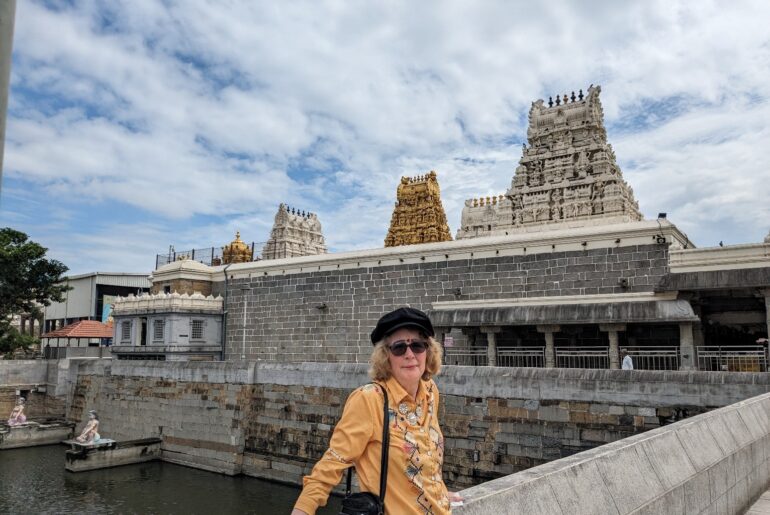
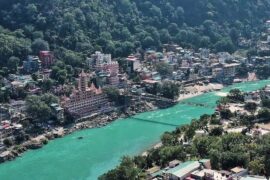

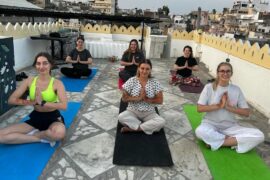
Comments are closed.